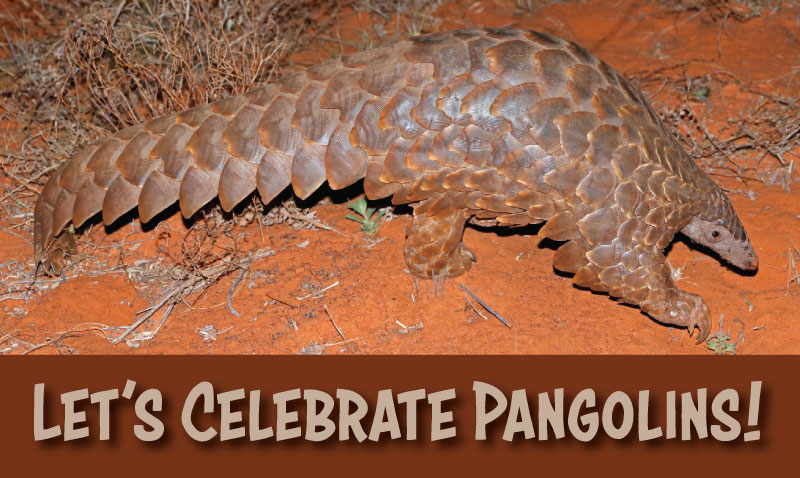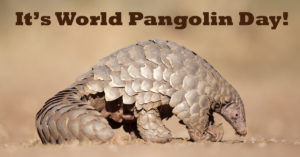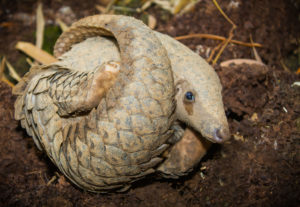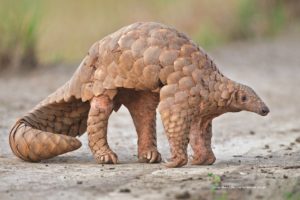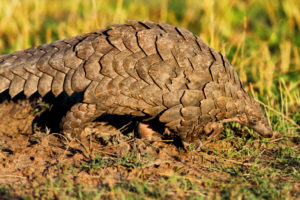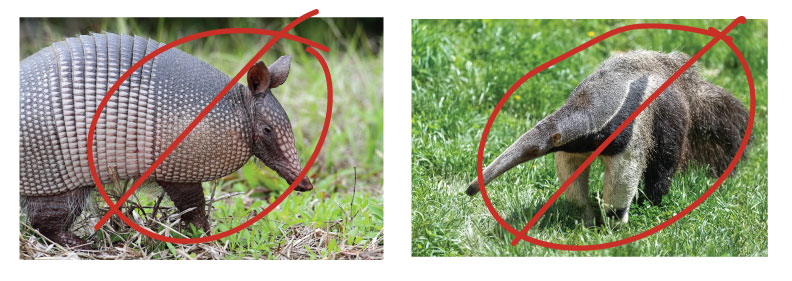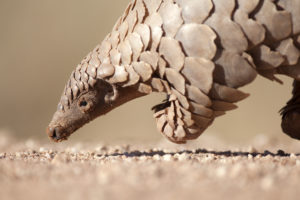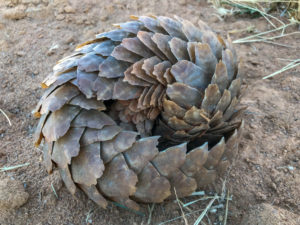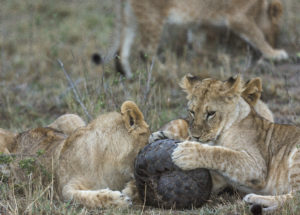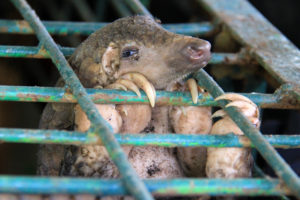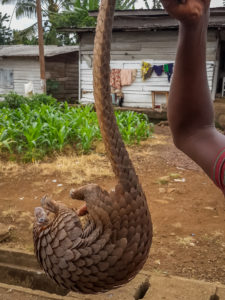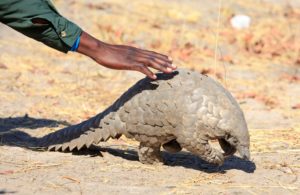World Pangolin Day is observed on the 3rd Saturday of February each year and so it’s a good time to reflect on this incredibly unique and endangered mammal. In this blog post, you’ll learn fascinating facts about pangolins and also learn how to sketch several species in recordings of my previous online video workshops.
Sadly, pangolins are the most illegally trafficked mammals on the planet, with up to 200,000 animals being poached from the wild EACH YEAR.
They are poached for their meat, which is eaten as a luxury dish in parts of their range, and their scales, which are used as talismans, jewelry, and in traditional Asian medicine. Perhaps there is a glimmer of hope, which I’ll share later. But first, let’s learn some interesting facts about this little-known animal.
Fascinating Pangolin Facts
- One adult pangolin consumes an average of 70 million insects in one year – great pest control! They dig them up with their long claws and slurp them up with a tongue that’s longer than they are!
- Pangolins serve an important ecological role by keeping ant and termite populations in check so that these insects don’t eat too much of the leaves and grasses in the areas they live in.
- Pangolins don’t have any teeth! Instead, they have keratinous scales lining their stomachs. These, along with small pebbles, help to break up food that is swallowed whole.
- Pangolins can use their tails to support themselves while they walk upright on their back legs. They can also use them to defend themselves or to compete for mates.
- Pangolin babies hitch rides on mom’s back and tail and are known as ‘pango pups’.

- Even though they may resemble armadillos with their scaly plates or anteaters with their long snouts, they are actually not very closely related to either, except that all are mammals.
- The name pangolin comes from the Malay word “penggulung” which means “one who rolls”. This describes a pangolins tendency to roll into a ball when threatened, using the scales on its back as protection.
- The earliest pangolin fossil dates back to the Paleocene. While extant species today are only found in Asia or Africa, fossils have been found of extinct species from North America.
- The pangolin is one of Sir David Attenborough’s favorite creatures. In his film “Attenborough’s Ark”, he lists the pangolin as one of ten species that he would save from extinction if he could. He recounts a story about a strange scaly creature called a Sunda Pangolin that he rescued from the cooking pot while filming in Asia early in his career. These creatures, which are similar to anteaters, have hard scales made of keratin, the same material human nails are made from.
- They are heavily hunted for use in black market medicine in Vietnam and are highly prized for meat. “It is one of the most endearing animals I have ever met,” said Sir David. “Huge numbers of them are illegally exported, mainly to China. In the last 15 years, over half of the population of Sunda Pangolins have disappeared” he said in 2012.

Victorian engraving of an anteater. Digitally restored image from a mid-19th-century Encyclopaedia.
What are pangolins and where do they live?
Pangolins are very unique and curious-looking mammals.
Pangolins are primarily nocturnal and depending on the species, live in either savannas or forests. Some species, like the black-bellied Pangolin, are almost entirely arboreal, spending most of their lives in trees. Pangolins have long claws that they use to enhance and enlarge burrows made by other animals (or make their own) and these are where they live and raise their young.
These animals can vary in size from about 3 pounds up to 75 pounds! They are covered with large, overlapping scales except on their underside, which is sparsely covered in coarse fur. They can be varying shades of earth tones – ranging from dark yellow to brown. Asian species have bristly hairs that stick up between their scales while African species do not. Pangolins have small, conical heads and a small snout. They have large, muscular tails and five toes on each of their legs. The middle three toes of their front feet possess long, curved claws adapted to be used to excavate their burrows and to dig into ant and termite nests.
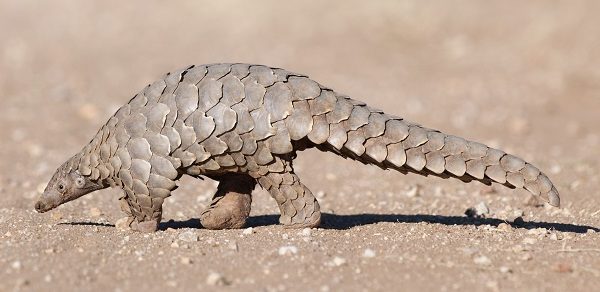
How many species of pangolins exist?
Pangolins are taxonomically distinct, belonging to their own order (Pholidota), family (Manidae), and genus (Manis).
There are only eight recognized species of pangolins alive today, although fossils have been discovered of other species from the distant past.
Four species are found in sub-Saharan Africa and are named for what they look like: Black-bellied Tree Pangolin, White-bellied Tree Pangolin, Giant Ground Pangolin, and Ground Pangolin.
Four are found in Asia and are named according to where they live: Chinese Pangolin, Indian Pangolin, Philippine Pangolin, and Sunda Pangolin.
The species can be identified by their variations in size, color, scales, face, tails, and habitat. Some are heavier-bodied and dwell on the ground while others are arboreal with long prehensile tails. Asian species have bristly hairs that stick up between their scales while African species do not.
An excellent guide to all 8 species can be downloaded from the USAID Wildlife Asia website.
Who are pangolins related to?
While pangolins may resemble creatures such as aardvarks, armadillos, or anteaters, genetic analysis suggests that they are most closely related to animals that are found in the order Carnivora, such as cats and dogs! Like armadillos, pangolins are covered in protective plates and both can roll up into a ball to protect themselves from predators. Like anteaters and aardvarks, pangolins eat nearly nothing else besides ants and termites. One of the common names for pangolins is ‘spiny anteaters’ which only adds to the confusion!
Therefore convergent evolution is a good explanation for the similarities between pangolins and these creatures – the need to eat the same type of insects led to the independent evolution of certain structures to help them do so!
What do pangolins eat and who eats pangolins?
Pangolins are only known to eat ants and termites. A pangolin laps up these insects with its long, sticky tongue which is lubricated by a hyperactive salivary gland and, due to its length, is attached near its pelvis. When fully extended, this tongue can be longer than the entire body of the animal itself! This allows it to probe anthills and termite mounds for its prey. Without teeth, pangolins lack the ability to chew; however, while foraging, they ingest small stones (called gastroliths) that accumulate in their stomachs. Their stomachs are also lined with keratinous spines to help to grind up ants they eat.

They use their long front claws to pry up bark in search of ants and termite mounds in search of termites. Their good sense of smell and hearing helps them pinpoint their prey, though their eyesight is poor. Special muscles can close their ears, nostrils, and eyes to protect them from biting insects, as can their formidable scales.
Pangolins have different predators depending upon where they live, though not many animals can get through their protective armor-like scales, especially when they roll up into a ball.
Lions, tigers, leopards, hyenas, and even pythons are known to include pangolins in their natural diet.
Why Pangolins are Threatened
Tragically, humans are the biggest predator of pangolins. Not even their medieval-looking coat of armor can protect them from the greed and avarice of the human species.
Each of the world’s eight species of pangolins is threatened by poaching, with all eight on the IUCN’s Red List. The four Asian species are all listed as either endangered or critically endangered. Therefore, pangolins are considered one of the most illegally trafficked mammals in the world. They are sought after for their meat, which is served as a delicacy and a way to exhibit status in some parts of the world. Additionally, their scales are falsely believed to have some use in traditional medicines.
They are dried and mixed with a variety of other substances to “cure” a number of ills including nervousness, malarial fever, demon possession, and deafness. But they have no magical powers and are in fact only made of keratin, the substance our fingernails are made from. Finally, like most endangered species, pangolin habitat is disappearing rapidly through conversion to agriculture and tree plantations such as oil palm.
Pangolins are also killed by being electrocuted on electric fences meant to keep livestock in and predators out.
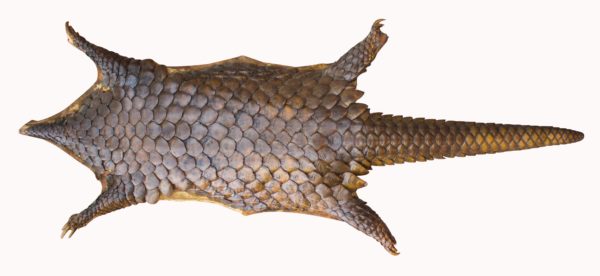
Why are pangolins vulnerable to extinction?
Besides the fact that pangolins are hunted extensively for their meat and their scales, their life history characteristics make them even more vulnerable to extinction than other animals. This is because they have very slow reproductive rates, with the females only having 1-3 offspring (known as a pango pup) at a time with a gestation period lasting months depending upon the species. Being very shy, timid, and reclusive animals makes them nearly impossible to breed or rescue and rehabilitate. Their very specialized diet of ants and termites limits where they can live and makes it even harder to provide them with this diet in captivity. Their habitats are also at risk, being converted into oil palm plantations, cleared for development, and logged for its trees.
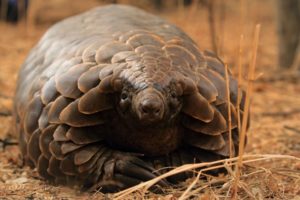
What Is Being Done to Save Pangolins?
The greatest threat to pangolins is greed and misinformation. Unless the demand for pangolin scales, skin, and meat can be reduced, pangolins in the wild have little hope. And the fewer there are, the higher the prices go and the more tempting it will be for poachers to capture them. Like elephant tusks and rhino horns, pangolin scales are falsely believed to have medicinal and magical properties. It is up to the consumers of these animal parts in the countries that use them to refute their medicinal properties.

Education and awareness are the first steps to helping the pangolins. As these creatures are solitary and secretive, even biologists don’t know much about their habits and characteristics. They are continuing to develop innovative ways to study these animals and learn more about them. Here are a few examples of how conservation organizations are helping save pangolins.
- Wildlife biologists are studying the habits and habitats of wild pangolins through the use of motion sensor cameras and tracking devices.
- Biologists are studying methods for caring for pangolins in captivity so those that are rescued alive from poachers can be rehabilitated and released back into the wild.
- Conservation groups are educating villagers where pangolins live about their plight and helping the people to develop alternatives to the income from poaching pangolins.
- Education programs teach youth and adults about pangolins in the countries where the demand is the highest for their scales and meat.
- Media campaigns are being launched in countries where demand for pangolin body parts is highest, for example, this project in Vietnam.
- Laws are being strengthened to make it illegal to hunt pangolins and sell or possess their meat, skins, and scales.
- All pangolins have now been officially listed as either vulnerable, endangered, or critically-endangered on IUCN Red List, which helps bring awareness to their plight.

PANGOLIN EDUCATION AND SKETCHING WORKSHOPS
Temminck’s Pangolin Workshop
Before you begin the video below, I suggest that you download your 3-page handout of pangolin photographs to practice sketching from, including the one I demonstrate in the video below.
Tree Pangolin Workshop
Watch the replay below of a live workshop I taught on pangolins where you’ll learn about the species, where they live, their behavior, and their anatomy. Then I’ll lead you through a step-by-step demonstration of drawing the tree pangolin, Phataginus tricuspis, of equatorial Africa.
CLICK HERE to download your tree pangolin image then click the image below to begin the workshop (90-minutes long).
Indian Pangolin Workshop
Below you’ll find a recording of another workshop I taught. I recommend that you download the Indian Pangolin image in order to follow along.
Learn More About Pangolins
Check out the following resources to learn more about pangolins, their habits, habitats, and why they are all critically endangered and threatened with extinction.
-
-
-
-
- Pangolin Crisis Fund
- WildAid Pangolin Progam and their 2021 video series, A Pangolin’s Tale.
- Scales Conservation Fund
- Pangolin Protection Network / Pangolino
- Pangolin.Africa, producers of the film Eye of the Pangolin
- Pangolin Conservation and Research Foundation
- Save Pangolins
- Pangolin Species Identification Guide
- Encyclopedia of Life
- Zoological Society of London
- IUCN SSC Pangolin Specialist Group
- African Wildlife Foundation
- Pangolin Conservation
- Pangolins International
- Nifty Pangolins
- Save Vietnam’s Wildlife
- Tikki Hywood Trust
- Traffic – Wildlife Trade Specialists
- Edge of Existence
- African Pangolin Working Group
- US Fish and Wildlife Service MENTOR-POP Program
- World Pangolin Day
- Pangolin Protection Network / Pangolino
- Pangolin.Africa, producers of the film Eye of the Pangolin
- Environment and Community Development Association of Cameroon
Movies about the Pangolin Poaching Problem
The following video by National Geographic is a sobering reminder of their fate. Warning: contains some graphic footage, not for young viewers.
-
-
-

